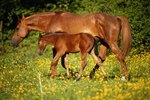Swayback or lordosis is weakening of a horse's supporting ligaments along the spine. Causes of lordosis include genetics, pregnancy, age, conformation, excessive strain on the back and lack of exercise. Lordosis can't be completely cured, but horses with swayback can remain active well into their older years if you take steps to strengthen the back with muscle-building exercises.
Carrot Stretches
Carrot stretches build a horse's back by stretching the spine and surrounding ligaments. The basic principle of carrot stretches is that you hold bait, a carrot or other small item of food close enough to the horse that he'll stretch to it. Move the bait around -- such as toward a shoulder, elbow or hip -- to encourage your horse to move through his full range of motion, stretching, relaxing the body and releasing longstanding tension.
Ground Driving
Ground driving, also known as line driving, is a good alternative to regular riding for a horse too weak to carry a rider. Ground driving is an in-hand technique whereby the horse is equipped with a surcingle, a bridle and a pair of long driving reins. A handler holds the reins and walks behind the horse to drive him forward. When done properly, line driving corrects riding by encouraging the horse to swing and lift his back by engaging his abdominal muscles.
Longeing
Free-longeing and longeing with side reins at an animated walk or energetic trot encourages the horse to drop his head and round his back. To longe correctly, the horse must move forward with enough energy to stretch his legs under him and round his back -- if a horse longes too fast or too slow, he will not be able to relax his back. If you are unfamiliar with longeing, consider contacting a horse trainer to instruct you.
Cavaletti
Cavaletti work, which is longeing or riding over poles on the ground, encourages a horse to lower his head and lift his back. The cavaletti serves in numerous configurations to help develop and improve balance, muscle fitness, flexibility and strength in the back of a horse.
Weight
Healthy horses are less likely to develop lordosis. Actual amounts of feed required by horses to maintain muscle tone varies by size, age, climate and work load. If you have a horse with a swayed back, consider contacting your veterinarian or equine nutritionist to develop a feeding plan to help build muscle and prevent obesity.
Cushing’s Disease
If you notice your horse developing a swayed back while gaining a hay belly -- a larger than average stomach -- ask your veterinarian to test for Cushing's disease. Cushing's disease is caused by a pituitary tumor that overstimulates the adrenal glands and produces a high amount of cortisol. Cortisol interferes with cells' ability to utilize fuels, resulting in weakness and loss of muscle bulk over a short period of time.
References
Writer Bio
Alie Maheux has been a freelance writer and researcher since 2007. She writes for several online firms, and specializes in business, health, travel, and equine related journalism. Maheux holds a Bachelor of Arts in business and economic science from Saint Leo University and she is perusing a Master of Science in occupational therapy and medical anthropology.




